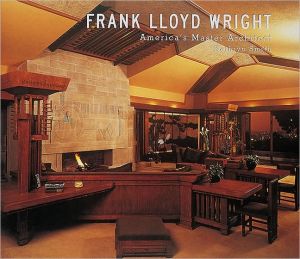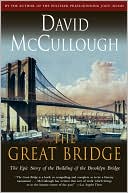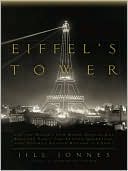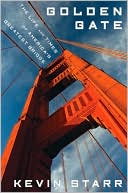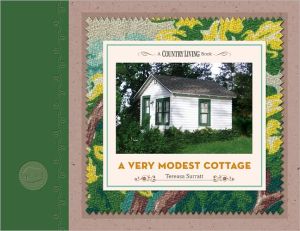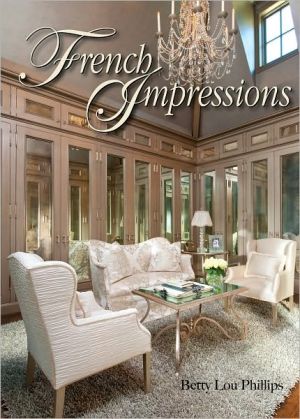Frank Lloyd Wright: America's Master Architect
Frank Lloyd Wright (1867-1959) is unquestionably America's most celebrated architect. In fact, his career was so long and his accomplishments so varied it can be difficult still to grasp the full range of Wright's achievement. In this new study, Wright scholar Kathryn Smith does just that, exploring the grace and beauty found in all facets of Wright's work: from office desks and chairs to his first residential commissions, from magazine cover designs to major public buildings. The concise...
Search in google:
This comprehensive and affordable view of the master architect's entire oeuvre includes private residences, public buildings, furnishings, and decorative pieces.BooknewsBrilliant color photographs and concise text chart Wright's entire career, beginning with his apprenticeship before the turn of the century and continuing through the Prairie period, his years in Japan and California, his major designs of the late 1920s and 1930s, his Usonian houses, and the works of his last decade. The 9.25x10.5
Introduction: America's Master Architect\ "[I]n this work I think it would be well to see the growth of the idea." --Wright to the Taliesin Fellowship, August 13, 1952\ While there is little dispute that Frank Lloyd Wright (1867-1959) is America's greatest architect, there is a general lack of agreement as to the source and the extent of his achievement. His prodigious legacy embraces decorative art, graphic art, houses, public buildings, commercial buildings, and town planning; indeed, everything needed for a total living environment. Wright's philosophy of organic architecture sought unity in every detail, from furniture to freeways. Over his seventy-year career, he explored ideas that began with the American home and expanded to include the relationship between architecture and landscape and, finally, the relationship between architecture and community. As in a symphony, themes in his work develop, repeat, fall away and return again, in rhythmic patterns. Ultimately, Wright's vision was optimistic; he sought a harmonious balance between man, nature, and society.\ Wright took inspiration from both the future and the past. His social philosophy, although grounded in Jeffersonian democracy, was outside the mainstream of its day. Pragmatic and idealistic, autocratic and populist, nostalgic and prophetic--it combined an Emersonian view of the moral good of nature with an American trust in self-reliance. It was based on a romantic understanding of complex economic and social forces as the underpinnings for a new society.\ To understand Wright's philosophy requires knowledge of his formative experiences. His life began in 1867 in rural Wisconsin shortly after the Civil War.Westward settlement was swiftly transforming the virgin wilderness that was home to Native Americans into an agrarian countryside. With a family background in Unitarianism he absorbed the ideas of the Transcendentalists, especially Ralph Waldo Emerson and Henry David Thoreau. The notion of the preeminence of nature, gained from both experience and literature, made a vivid impression on the young Wright. After his arrival in Chicago in 1887, he quickly grasped the implications of the Industrial Revolution, both positive and negative, and began to forge a genuinely authentic American architecture, one in contrast to the European historical styles that dominated the times.\ After an apprenticeship with the firm of Adler and Sullivan, in 1893 he established his independent practice in Oak Park, Illinois, by turning his attention to the American home. His goal was nothing less than the creation of the beautiful house in every detail. From the building itself to the furniture, carpets, and table linens, everything attracted his scrutiny, even arrangements of flowers and books.\ Wright's formative years came to an end at the turn of the century with his development of a new type of American dwelling--the Prairie House--which, from its debut, started an international revolution that continues to reverberate. Suburbia, a unifying decorative scheme, and a reverence for family life merge in the Prairie House to create a building that, although dedicated to conservative values, was a radical departure from precedent due to its open spatial plan. Emanating from a consistent set of principles, the Prairie House nevertheless offered a variety of solutions to fit differing clients, budgets, and sites.\ The period 1903-6 is critical. At this time, Wright made a commitment to modern materials, primarily reinforced concrete, with Unity Temple in Oak Park; and he introduced an austere abstraction with the Larkin Administration Building in Buffalo. For the remainder of this period, he continued to produce numerous houses for middle-class families and several on a very grand scale when the client and budget permitted.\ Feeling restricted by suburbia both personally and professionally, Wright soon sought a wider context for his expression. Redefining his ambitions in 1911 with the building of a new house and studio, Taliesin, he began an exhaustive search for a language that would reestablish a vital connection between architecture and nature, a link that Wright believed had existed in preliterate cultures.\ Where Wright had used representation in the Prairie House, he now chose abstraction. For instance, in the art glass of the earlier Dana House (1902-4) in Springfield, Illinois, crystallized butterflies float over the dining room table as hanging lamps, and light plays against the stylized sumac leaves of the windows as if the house were being caressed by the forest. Taliesin became instead a metaphor for the surrounding landscape. Low rooflines echoed the profile of the hills, the walls were stained the color of the sand of the neighboring Wisconsin River, and native stone was laid up in horizontal layers to recall the stratified rock nearby.\ The transition from the elaboration of a decorative style to the creation of a potent symbol of nature was facilitated by Wright's contact with Asian art. He had begun collecting Japanese prints as early as 1902. In 1905, he left the United States for the first time to spend three months in Japan. With information clearly gained in advance from books and Japanese associates, Wright systematically sought out historic shrines and gardens, Japanese art and craft. By 1916, when he sailed for Japan to spend the majority of the next six years in Tokyo building the Imperial Hotel, he was eager to accumulate not only thousands of wood block prints, but screens, textiles, ceramics, printed papers, bronzes, sculptures, and rugs. Intellectually, these six years were ones of study and reflection, in which Wright found inspiration for many of the themes that would rejuvenate his work between 1925 and 1936. In Asian art, Wright discovered an aesthetic that revealed the inner geometric structure of nature, and which used elements of flora and fauna to symbolize a powerful and meaningful cosmology. His early exposure to and background in Transcendentalism prepared him for these points of view but not for the complex task of translating them into architectural form.\ With the Hollyhock House (1916-21) in Hollywood, California, Wright began to refine the elements that would constitute his new domestic vocabulary: earth, fire, water, and the dome of the sky. By the 1920s, with his invention of a concrete block system of construction, he had created the perfect fusion of art and nature. These square concrete blocks, made partly of decomposed granite excavated in situ, were intended for all walls, floors, and even the roof. Structure and ornament, the building and the earth, became one.\ In the following years, until his death, Frank Lloyd Wright designed on many levels simultaneously; he would introduce and reintroduce a given architectural idea in building after building until he perfected his composition. At the same time, he initiated new directions and areas of investigation beyond the strict confines of architecture. He was stimulated by the development of a personal aesthetic as well as the changing needs and demands of society. Although he almost always designed as the result of a specific commission from a client, on occasion he would investigate a theoretical problem in a fully worked-out scheme, usually for publication or exhibition. This dual evolution had particular relevance for the period between 1925 and 1936, in which he culminated his exploration of the connection between architecture and nature with the masterful Edgar J. Kaufmann country house, Fallingwater, and began to formulate his ideas for a new social order.\ Wright's planning principles were now formed against the backdrop of the Great Depression, which challenged the average American's trust in the status quo. He presented his planning scheme in a model and text that he exhibited at Rockefeller Center in 1935. He called his vision "Broadacre City" to both confuse and confound his critics. Although the low-density zones of his Usonia (a term coined to refer to the United States of America) did, indeed, require a minimum of one acre of land per family, the resulting form of the metropolis did not conform to the prevailing definitions of a city. Decentralization, which he predicted would ultimately spread across the entire nation and swallow up all existing urban centers, was made possible by the automobile, telephone, radio, and television. The historical need for vertical density--geographic proximity to work and culture--had been made obsolete by modern transportation and telecommunications. "The city would go to the country," as Wright predicted, but without the urban congestion that he believed was the root of all economic and social injustice.\ Lacking support for his reforms from any government, federal or local, Wright carried out his ideas on a smaller scale with individual clients. He had not forgotten the middle-class families that had formed the core of his practice during the Prairie House period; Broadacre City was to be built one Usonian House at a time. In the period between the Depression and the beginning of World War II, affordable middle-class housing was in short supply and Wright directed his attention to the construction system as well as the plan. The Usonian House formed a "kit of parts," a standard vocabulary of elements for the erection of floors, walls, windows, fireplaces, and roof. It assumed the elimination of the contractor as middle-man between architect and client. It challenged the homeowner to become involved in the construction of his own house. With efficient spaces, judicious proportions, and the elimination of the inessential, it embodied the ideal of "a natural house."\ Between the end of World War II and his death in 1959 at the age of ninety-one, Wright would have abundant opportunities to express his views on man, nature, and society; during this period, he received more commissions than at any other stage of his career. The buildings he designed at this time are distinguished by their optimistic mood. The Usonian Automatic method of concrete block construction revived his earlier system of the 1920s for a generation of American veterans returning from the war. Indeed, the postwar housing shortage provided an opportunity to demonstrate the theory that decentralization in a mobile society could provide open space, light, and intimate contact with nature for all Americans.\ In the 1950s, Wright's studio was filled with projects for churches, office buildings, schools, hotels, and theaters. The dozens of schemes that he produced for the Solomon R. Guggenheim Museum in New York during the 1940s and 1950s were proof of his continued facility and tenacity. The solid rectangular blocks of the first decades of the century had given way to fluid curves encircling yet not containing space. With the Guggenheim Museum, Wright seems to have attained the promise of his earlier work--a building of continuity and plasticity that was a direct expression of the modern materials that formed it.\ Frank Lloyd Wright sought to reconcile many of the opposing forces of the twentieth century: the rationalism of the machine with the mysteries of the earth, the rights of the individual with the need for community. Although Wright was a futurist, he dedicated his cause to traditional architectural values. The very paradoxes and contradictions that make him so difficult to compartmentalize are what give him such lasting appeal. His aesthetic prowess is unchallenged: masterpieces such as Fallingwater, Unity Temple, the Robie House, the Guggenheim Museum, and many more are among the greatest architectural landmarks in the United States, and possibly the world. At an early age Wright announced that his ambition was to become not only the greatest architect of his generation, but the greatest architect that ever lived. It is too early to render a judgment, but there is no doubt that his legacy will continue to influence generations well into the next century.
Introduction: America's Master Architect Formative Years (1887-1899) Prairie Period (1900-1910) Japan and California (1911-1924) Regeneration and Renewal (1925-1936) Usonian Period (1937-1947) Late Works (1948-1959) Wright's Art Collection Chronology Suggestions for Further Reading Index Author Biography: Kathryn Smith is the author of Frank Lloyd Wright's Taliesin and Taliesin West (1997) and Frank Lloyd Wright, Hollyhock House, and Olive Hill: Buildings and Projects for the Aline Barnsdall (1992). Smith is former Professor of Architecture at the Southern California Institute of Architecture.
\ BooknewsBrilliant color photographs and concise text chart Wright's entire career, beginning with his apprenticeship before the turn of the century and continuing through the Prairie period, his years in Japan and California, his major designs of the late 1920s and 1930s, his Usonian houses, and the works of his last decade. The 9.25x10.5<"> volume also contains examples of drawings, furniture, and decorative arts as well as a glimpse at his seldom-seen collection of Asian art which provide a key to understanding Wright's views on art and nature. Annotation c. by Book News, Inc., Portland, Or.\ \
